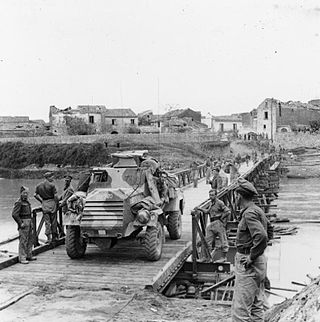Otter light reconnaissance car
Light reconnaissance car From Wikipedia, the free encyclopedia
The Otter light reconnaissance car, known officially by the British as "Car, Light Reconnaissance, Canadian GM (R.A.C.)",[1] was a light armoured car produced in Canada during World War II for British and Commonwealth forces.
| Otter light reconnaissance car | |
|---|---|
 An Otter crossing a Bailey bridge over the Volturno river at Grazzanise in October 1943 | |
| Type | Light reconnaissance car |
| Place of origin | Canada |
| Service history | |
| Used by |
|
| Wars | |
| Production history | |
| Designer | General Motors Canada |
| Designed | ~1942 |
| Manufacturer | General Motors Canada |
| Produced | 1942 – 1945 |
| No. built | 1761 |
| Specifications | |
| Mass | 4.37 long tons; 4.89 short tons (4.44 t) |
| Length | 4.50 m (14 ft 9 in) |
| Width | 2.16 m (7 ft 1 in) |
| Height | 2.44 m (8 ft 0 in) |
| Crew | 3 |
| Armour | up to 12 mm |
Main armament | .55 in (14.0 mm) Boys AT rifle |
Secondary armament | 0.303 in (7.7 mm) Bren light machine gun |
| Engine | GMC 6 cyl. gasoline 106 hp (79 kW) |
| Power/weight | 24.1 hp/t (18.0 kW/t) |
| Drive | 4×4 |
| Suspension | Leaf spring |
| Maximum speed | 75 km/h (47 mph) |
Design
Summarize
Perspective
The Otter light reconnaissance car (LRC) was developed by General Motors Canada to meet the demand for this type of armoured car.
The Otter followed the layout of the British Humber Mark III LRC, based on the Chevrolet C15 CMP truck chassis and used many standard GM components. It took a crew of three – driver and commander seated in the vehicle front, while the gunner occupied the turret position at the rear. A Wireless Set No. 19 was mounted in the rear with A and B set aerials extending from the rear of the fighting compartment on mounting arms.
The primary armament consisted of a hull-mounted Boys anti-tank rifle and a Bren light machine gun in a small open-topped turret. A smoke discharger is mounted alongside the mounting for the Boy's anti-tank rifle.
Although it used a more powerful engine than the Humber, it was larger and heavier (by a ton); overall performance was less than that of the Humber but still acceptable.
Production
Between 1942 and 1945, 1761 units were produced in Oshawa, Ontario, though fewer than 1,000 were delivered overseas.[2]
Variants
History
The Otter served with Canadian units in the Italian campaign and Northwest European operations. It was also employed by the South African Army[5] and the British RAF Regiment. Some RAF regiment vehicles used aircraft armament such as 20mm cannon and 0.303 Browning machine guns. After the war, the Otter was used by the Jordanian Army during the First Arab-Israeli War and Dutch Army during the Indonesian Revolution. The Syrian Army also operated the type after the war, with turretless Otter armed with 7.5 mm FM 24/29 light machine gun in pintle mounts or with 37 mm Puteaux SA 18 in a turret taken from other British-built armoured car.[6]
Surviving vehicles
Gallery
- Otter armoured car captured by the Haganah from the Arab Liberation Army in 1948.
- GMC Otter light reconnaissance car, Bridgehead 2011
- Otter at the Amersfoort Cavalry Museum
- RAF Regiment Otter at Prkos Airfield
- Otter MK1 at Katakolo beach, Greece. This image was taken at the place where Otters landed at on 24 September 1944. The vehicle itself is part of the Hellenic Historical Vehicles Preservation Club collection in Greece. (www.sdio.gr)
See also
References
External links
Wikiwand - on
Seamless Wikipedia browsing. On steroids.





